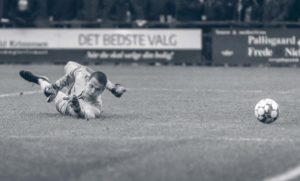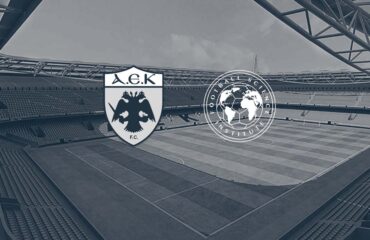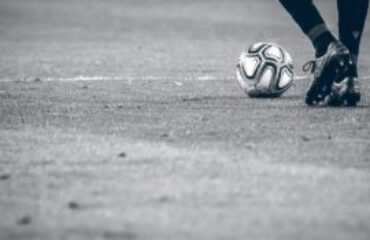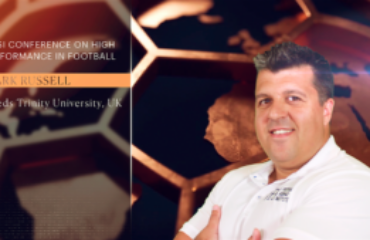1. Soccer goalkeeper expertise identification based on eye movements.
Hosp BW, Schultz F, Höner O, Kasneci E.
Human-Computer Interaction, University of Tübingen, Tübingen, Germany. (2)Institute of Sport Science, University of Tübingen, Tübingen, Germany.
This study captured omnidirectional eye movements associated to in-field scenes displayed through virtual reality glasses in 35 goalkeepers of different levels of expertise. Based on the gaze behavior of each player, their expertise was classified with common machine learning techniques, showing that eye movements contain highly informative features and thus enable a classification of goalkeepers between three stages of expertise at a high accuracy of 78.2%, highlighting the importance of eye movement capacities in goalkeepers.
PLoS One. 2021 May 19;16(5):e0251070. doi: 10.1371/journal.pone.0251070. eCollection 2021.
2. Hamstring muscle injury in the athlete: state of the art.
Silvers-Granelli HJ, Cohen M, Espregueira-Mendes J, Mandelbaum B.
Musculoskeletal Research Center, Velocity Physical Therapy, Santa Monica, California, USA hollysilverspt@gmail.com
This review paper describes hamstring injuries (HSI) incidence and prevalence of HSI in athletes, discuss risk factors and the mechanisms of injury for HSI, how to properly diagnose, image and prognosticate appropriate return to sport (RTS) for individuals who have sustained an HSI, prescribe treatment and prevention strategies and to discuss relevant options to decrease overall risk of primary and secondary recurrence of HSI.
J ISAKOS. 2021 May;6(3):170-181. doi: 10.1136/jisakos-2017-000145. Epub 2020 Nov 12.
3. Drop jump neuromuscular performance qualities associated with maximal horizontal deceleration ability in team sport athletes.
Harper DJ, Cohen DD, Rhodes D, Carling C, Kiely J.
Institute of Coaching and Performance, School of Sport and Health Sciences, University of Central Lancashire, Preston, UK.
This study in 29 university athletes investigates associations between Drop Jump on force plate from 20 (DJ20) and 40 cm (DJ40) heights and (2) maximal horizontal deceleration (HDEC), measured using radar, following a 20 m acceleration. DJ20 and DJ40 reactive strength index (RSI) and concentric mean force had the largest correlations with HDEC, and eccentric mean force in DJ40 had a much larger difference between high and low HDEC groups than DJ20, suggesting that DJ RSI may be used as a proxy for HDEC ability, and that a higher height is more useful to distinguish those with a better capacity to generate eccentric braking forces.
Eur J Sport Sci. 2021 May 19:1-16. doi: 10.1080/17461391.2021.1930195. Online ahead of print.
4. Do exercise-based prevention programmes reduce non-contact musculoskeletal injuries in football (soccer)? A systematic review and meta-analysis with 13 355 athletes and more than 1 million exposure hours.
Lemes IR, Pinto RZ, Lage VN, Roch BAB, Verhagen E, Bolling C, Aquino CF, Fonseca ST, Souza TR.
Universidade Federal de Minas Gerais (UFMG), Belo Horizonte, MG, Brazil.
This systematic review selected 10 original randomized controlled trials with 13 355 football players and 1 062 711 hours of exposure for analysis, showing very low-quality evidence that exercise-based prevention programs reduced the risk of non-contact musculoskeletal injuries by 23% (0.77 (95% CI 0.61 to 0.97)) compared with a control group, concluding that future high-quality trials are still needed to clarify this issue.
5. “The Referee Plays to Be Insulted!”: An Exploratory Qualitative Study on the Spanish Football Referees’ Experiences of Aggression, Violence, and Coping.
Devís-Devís J, Serrano-Durá J, Molina P.
Departament d’Educació Física i Esportiva, University of Valencia, Valencia, Spain.
This study used a qualitative interview of a group of 8 football referees (4 males and 4 females). Results indicated that the most frequent aggressions experienced during matches were verbal abuse. Most of the aggressions from spectators were of a sexist or racist nature, and smiling and not considering insults as a personal matter were two emotional-focused coping strategies used. The two most common referee responses to coaches’ and players’ verbal abuse were penalties and send-off calls.
Front Psychol. 2021 Apr 28;12:656437. doi: 10.3389/fpsyg.2021.656437. eCollection 2021.
6. Foam rolling during a simulated half-time attenuates subsequent soccer-specific performance decrements.
Kaya S, Cug M, Behm DG.
School of Human Kinetics and Recreation, Memorial University of Newfoundland, St. John’s, Newfoundland and Labrador, Canada; and Football Science Institute
This study in 13 male soccer players compared Foam Rolling FR (5 exercises on both legs for 45-s each) versus passive recovery during a simulated half-time period on a simulated second-half task. Results showed no significant changes between conditions for Total Quality of Recovery, Loughborough Soccer Pass Test, Blood Lactate, and Heart Rate. However, while all sprint speed measures (mean, best of 15 sprints and mean of the first 5 sprints) significantly decreased with the passive condition, no decrement was noted in these sprint measures with the FR condition, thus showing some evidence that FR may be beneficial to attenuate sprint speed impairments during second-half soccer games.
J Bodyw Mov Ther. 2021 Apr;26:193-200. doi: 10.1016/j.jbmt.2020.12.009. Epub 2020 Dec 8.





